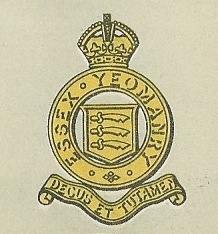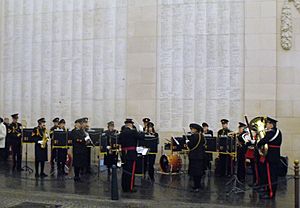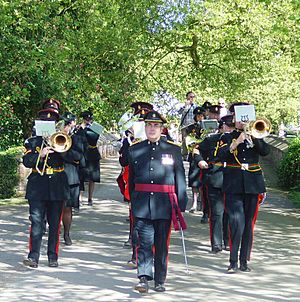Essex Yeomanry facts for kids
Quick facts for kids Essex Yeomanry |
|
|---|---|

Essex Yeomanry cap badge (1940s)
|
|
| Active | 1797–1828 10 February 1831 – 31 March 1877 13 February 1902–present |
| Country | |
| Branch | |
| Type | Yeomanry |
| Role | Signals |
| Size | Squadron |
| Garrison/HQ | Colchester |
| Motto(s) | Decus et Tutamen (Shield and Protection) – 1831–77; 1909 onwards Audacter et Sincere (Gallant and Loyal) – 1901–09 |
| March | The Coggeshall Man's Wedding |
| Engagements | World War I |
| Commanders | |
| Honorary Colonel | Colonel Timothy J.S. Allen, OBE |
| Notable commanders |
John Archer-Houblon George Palmer Richard Colvin Reginald Hobbs |
The Essex Yeomanry is a special part of the British Army's Reserve forces. It started way back in 1797. At first, it was a group of local Yeomanry Cavalry (soldiers on horseback) in Essex, England.
This unit has a long and interesting history. It fought as cavalry (on horses) in World War I. Later, it became an artillery unit (using big guns) in World War II. Today, its history is carried on by 36 (Essex Yeomanry) Signal Squadron. This squadron is part of the Royal Corps of Signals, which handles communications for the army.
Contents
History of the Essex Yeomanry
Early Days: French Wars (1797-1813)
Britain was at war with France in the late 1700s. To protect the country, the government asked counties to form local cavalry groups called Yeomanry. These groups would defend against invasion or help keep peace at home.
The first Yeomanry group in Essex was formed in 1797. Soon, many more groups appeared across the county. By 1803, there were 23 such groups in Essex, with over 1,200 men. They were ready to protect their homes.
As the threat from France lessened, the number of groups went down. In 1813, some of these groups joined together to form the 1st Essex Yeomanry Cavalry.
The 1800s: Changes and Challenges
After the big wars, the Yeomanry stayed active to help with any local problems. But in Essex, things were mostly calm. By 1827, only a few small groups remained. The government even stopped supporting them in 1828, and the last group was disbanded.
However, just two years later, there was unrest across the country. The government brought back support for the Yeomanry. A new group, the West Essex Corps of Yeomanry Cavalry, was formed. Its main job was to protect important factories. This group grew and became the West Essex Regiment of Yeomanry Cavalry.
By 1871, the unit was called the Essex Yeomanry Cavalry again. But it was getting smaller. In 1877, with only 46 men left, the unit was disbanded. Still, the spirit of the Yeomanry lived on. In 1889, Captain Richard Colvin started an Essex Troop within another Yeomanry unit.
The Imperial Yeomanry (Early 1900s)
The Second Boer War in South Africa showed Britain needed more soldiers. In 1899, the Imperial Yeomanry (IY) was created. This new force was made up of volunteers, often from the middle and upper classes. They were trained to fight on horseback.
Many men from Essex joined the IY. Captain Colvin, from the Essex Troop, even commanded a whole battalion of the IY. After the war, the existing Yeomanry regiments became Imperial Yeomanry. The Essex Imperial Yeomanry was officially formed. Lt-Col Colvin helped set up the new regiment, organizing its squadrons based on local areas.
Becoming the Territorial Force (1908)
In 1908, the Imperial Yeomanry became part of the new Territorial Force (TF). The Essex regiment simply dropped 'Imperial' from its name. It was now known as a Dragoons unit, which meant they were cavalry soldiers.
World War I: Fighting for Freedom (1914-1918)
When World War I began in 1914, many members of the Territorial Force volunteered to serve overseas. Because of this, TF units were split into three groups:
- 1st Line: These soldiers went to fight abroad.
- 2nd Line: These soldiers stayed home for defense, or for those who couldn't go overseas.
- 3rd Line: This group trained new soldiers to replace those fighting.
1/1st Essex Yeomanry: On the Front Line
The 1st Line Essex Yeomanry was sent to the Western Front in France in December 1914. They joined the 8th Cavalry Brigade.
Battle of Frezenberg Ridge (1915)
The regiment saw its first major fight at the Battle of Frezenberg Ridge on May 13, 1915. In heavy rain, they bravely charged with bayonets and took back a German trench. However, they faced heavy artillery fire and lost many men. Out of 302 soldiers, 161 were killed, wounded, or went missing. Their commanding officer, Lt-Col Deacon, was among those who died. This battle earned them the first Battle Honours of Ypres 1915 and Frezenberg.
Battle of Monchy-le-Preux (1917)
On April 11, 1917, during the Arras Offensive, the Essex Yeomanry led a charge on horseback. They advanced over open ground to capture high ground near Monchy-le-Preux. They faced heavy machine gun fire, and some troops were almost wiped out. But the Yeomanry and other units pushed on and took Monchy. They held their positions against strong German attacks for 18 hours. The Essex Yeomanry suffered 135 casualties, and almost all their horses were killed.
Later in the war, the 1/1st Essex Yeomanry was split up. Its squadrons joined other cavalry regiments, continuing to fight bravely.
A Hero: Harold Mugford, VC
One Essex Yeoman, Harold Sandford Mugford, was awarded the Victoria Cross (VC) for his incredible bravery. He was a shipping clerk who joined the Yeomanry in 1912.
During the Battle of Monchy on April 11, 1917, Lance-Corporal Mugford set up his machine gun in a very exposed spot. He fired at the enemy who were gathering for a counter-attack. Even after his helper was killed and he was badly wounded, he kept firing. A shell then broke both his legs, but he still stayed at his gun, telling his friends to find cover. He survived, even though he lost both legs, and was given the VC for his amazing courage.
2nd and 3rd Line Essex Yeomanry
The 2nd Line regiment stayed in the UK for home defense. It moved around different locations and eventually became a cyclist unit. The 3rd Line regiment was formed to train new soldiers. It provided replacements for the fighting units.
Between the World Wars (1920-1939)
After World War I, the regiment was reformed in 1920. It changed from being cavalry (soldiers on horses) to artillery (soldiers who operate big guns). It was renamed the 104th (Essex Yeomanry) Brigade, Royal Field Artillery. Its headquarters moved to Chelmsford, and it had batteries (groups of guns) in Colchester and Harlow. In 1938, it became the 104th (Essex Yeomanry) Regiment, Royal Horse Artillery (RHA).
World War II: Artillery Action (1939-1945)
When World War II started in 1939, the 104th (Essex Yeomanry) Regiment formed a second regiment to help with the war effort. This new unit was called the 147th Regiment RHA (Essex Yeomanry).
104th (Essex Yeomanry) Regiment, RHA
This regiment went to the Middle East in 1940. It fought in many important battles in the desert, including the famous Battle of El Alamein. After that, it moved on to fight in the Italian Campaign. The regiment finished its service in Austria in 1946.
147th (Essex Yeomanry) Field Regiment, RA
This new regiment was part of the D-Day landings in Normandy in 1944. They had special self-propelled guns called Sextons. They fought as a leading unit with the British 8th Armoured Brigade. They pushed through France, Belgium, the Netherlands, and into Germany.
After the Wars (Postwar)
The regiment was reformed in 1947 as the 304th (Essex Yeomanry) Field Regiment RA. In 1955, it got its Royal Horse Artillery name back. In 1967, due to defense cuts, the unit became smaller. It was reduced to a squadron called 70 (Essex Yeomanry) Signal Squadron. This squadron became part of the 71 Yeomanry Signal Regiment, which is part of the Royal Corps of Signals.
Today, the Essex Yeomanry's history is continued by 36 (Essex Yeomanry) Signal Squadron. They are still part of the 71 (Yeomanry) Signal Regiment.
Heritage and Traditions
Uniforms and Badges
The Essex Yeomanry has had different uniforms over the years. Early on, they wore green uniforms with scarlet (bright red) parts. They also wore special hats called Slouch hats. Later, they wore brass helmets with red plumes (feathers) for special events like the 1911 Coronation.
When they became artillery, they kept their unique Yeomanry cap and collar badges. From 1947 to 1965, they wore a special embroidered badge on their arms. It showed three seaxes (old swords) with green blades on a red diamond. After World War II, they wore Rifle green berets with their Yeomanry badge. Today, the Signal Squadron wears the Royal Corps of Signals badge on the green Essex Yeomanry beret.
The Essex Yeomanry Band
The Essex Yeomanry Band is one of the oldest military bands in the East of England. It started in 1809! In the early days, the commanding officer even paid for the band himself. They had a unique look, with a drummer on a white horse wearing a plumed turban.
Even when the Yeomanry became gunners in 1921, the band stayed active. They wore the full uniform of the regiment, including plumed brass helmets. The band was stopped during World War II but reformed in 1947. Today, the band continues to play, keeping the traditions alive.
Regimental Marches
A regimental march is a special piece of music for a military unit. Before World War I, the Essex Yeomanry's march was Hoch Habsburg. Later, in 1962, The Coggeshall Man's Wedding became their regimental march.
Battle Honours
Battle honours are special awards given to military units for their bravery in battles. The Essex Yeomanry earned many honours for its service in World War I, including:
For World War II, the Royal Artillery (which the Essex Yeomanry became part of) has a special motto: Ubique. This means "everywhere," because artillery units were involved in almost every battle. So, they don't list individual battle honours for World War II.
Memorials
There are special places that remember the Essex Yeomen who died in the World Wars. Their main war memorials are in St Peter's Chapel in Chelmsford Cathedral. There are also memorials for brave individuals like L/Cpl Harold Mugford, VC.
A memorial was dedicated in Saint George's Memorial Church, Ypres in 2009. It remembers the Essex Yeomen who died in the Ypres area and have no known grave. The regiment also has a memorial in Normandy, France, at Asnelles on Gold Beach.
See also
- Imperial Yeomanry
- List of Yeomanry Regiments 1908
- Yeomanry
- Yeomanry order of precedence
- British yeomanry during the First World War
- Second line yeomanry regiments of the British Army
- List of British Army Yeomanry Regiments converted to Royal Artillery




